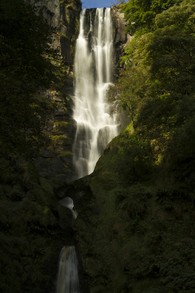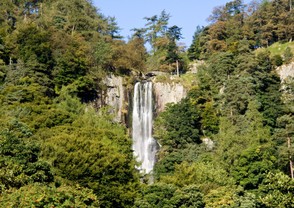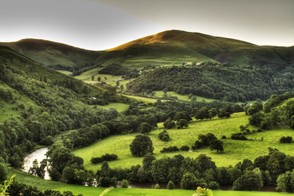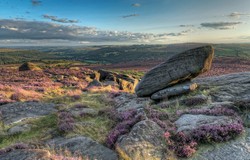Procopius, a sixth century Byzantine writer who had some dealings with English emissaries, took an interest in the distant island of Britannia; and he was somewhat daunted. In the west of the island, beyond the wall of Severus, lies a land of serpents, vipers and wild beasts, where the souls of men are brought, he declares. He had certainly his Geography wrong, as he confused the area with Scotland and he wrongly located Hadrian's wall, but the place where the Celts thought that men's souls were brought was the Berwyn Moorlands, on the borders of Wales, where the ancient Britons believed that the gateway to Annwn, [pronounced Annuvin] the realm of the dead, lay. On these sparse moorlands, the Cwn Annwn, the hounds of Annuvin. hunted,seeking souls of the dead roaming in the mist to hound into the underworld.
Look at the image below and enjoy Pistyll Rhaeadr, one of the seven wonders of Wales. This is a beautiful waterfall that drains the moors on Moel Sych towering above it, but for the Celts it was the gateway to a mysterious land. Not for nothing were the moors known as Rhos y Beddau, the moors of graves. Annuvin lay somewhere up there, and the moorlands contained deadly traps, bogs into which you could sink chest deep. This was a land that featured in the myths of Arthur, a Welsh warlord who was at home in that region, to the extent that one of the places on the Berwyn Ridge is known as Arthur's Table [Bwrd Arthur.]
The Welsh were so convinced that this was a magical place that the legend that travellers across the moor could be met by Gwynn ap Nudd, a Celtic underworld deity believed especially at large at Samhain [modern Hallowe'en.] developed. He would offer them food, but if they took it they were swallowed up into his underworld, never to escape. There is a legend that Gwynn once on the Berwyn Moors tried to capture St Coll, but Celtic saints were used to this kind of thing, so he resolutely refused, and then saw Gwynn's palace fade away, leaving him alone on the moor. He became the patron saint of nearby Llangollen.
Don't be unnecessarily alarmed. There is good walking on the main paths, especially along the ridge. I have only once put my foot into a bog hole, and as normally is the case I was wearing light coloured trousers at the time. I never go into mud except when I am wearing light clothes. Some mischievous sprite is behind this, I suspect. ,












 Women of the Gospelson 10/11/2025
Women of the Gospelson 10/11/2025
 Religious Gardenson 08/25/2025
Religious Gardenson 08/25/2025
 Doctor of the Church: John Henry Newmanon 08/03/2025
Doctor of the Church: John Henry Newmanon 08/03/2025
 Restoring the Palm Houseon 07/16/2025
Restoring the Palm Houseon 07/16/2025



Comments
I found nothing of value on the beach. But the search was fun.
Thank you for your comment below in answer to my previous observations and question.
Rockpooling and rolly poley appear quite educationally entertaining, entertainingly educational.
Did you find beach life or debris, trash or treasure? Did family and friends join in?
In remember doing it dry and clad.
Thank you for your comment in answer to my previous observations and question.
The image brought up by downhill rolling through soft sand causes me to consider possible parental reactions.
Did you always rolly-poley before or subsequent to dunking in beach and coastline waters?
Not rolly-poleying dry might have been quite a clothes-washing chore for your mother!
Rolly poley consists of rolling downhill. Lie on your side and roll down. Prestatyn is a little resort in North Wales with a dune system on the beach. Lovely soft sand
Thank you!
Rockpooling is an activity known to me and may be considered as an excellent preparation for my life as a water quality monitor of freshwater-stream invertebrates.
But playing rolly poley down Prestatyn dunes somewhat puzzles me.
What would rolly poley be and what would Prestatyn dunes in particular have that works so well with such an activity?
Whatever people do on the beach. For me it was rockpooling, or when I was very young playing rolly poley down the dunes at Prestatyn.
The introductory paragraph advises us that "the Welsh coast provides some of the best coastal recreation in Britain."
What does the phrase coastal recreation subsume? Might it be beach volleyball-playing, canoeing, sunning, swimming and windsurfing and more?
About a foot across.
The last paragraph to your first subheading, A Land where Myths are at Home, comments about light-colored clothes perhaps foretelling bog hole-walking.
Online sources only have big bog holes that look about the size of the vernal pool along the back yard. A hole that size I easily see during a day with sun and without driving precipitation.
What size was the hole that your eyes missed -- ;-D -- but your feet didn't?